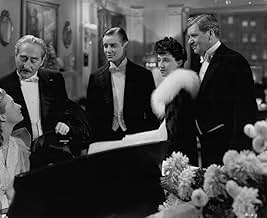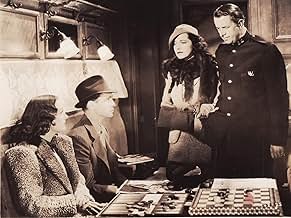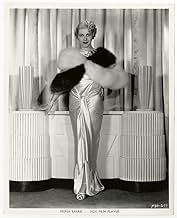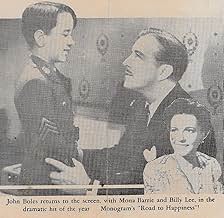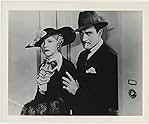Mona Barrie(1905-1964)
- Actress
- Soundtrack
Sometimes described as a poor man's
Kay Francis, brunette, hazel-eyed
Mona Barrie possessed neither quite the looks nor the personality
required to become a major player in 1930's Hollywood. Nonetheless, the
London-born and Australian-educated former childhood ballerina (born
Mona Barlee, daughter of veteran comedian Phil Smith) enjoyed a fairly
substantial career as a versatile 'second lead' for more than two
decades. Soon after being spotted by a talent scout on a Fifth Avenue
bus in New York, Mona signed with Fox in 1932 and was immediately cast
as one of two female leads in
Sleepers East (1934), a failed
attempt by Fox to remake MGM's all-star mega hit
Grand Hotel (1932) as a
train-bound crime drama. That same year, she also played a supporting
role in the post-Civil War romance
Carolina (1934), which established the
fact that she wore elaborate gowns exceedingly well. The New York Times
(January 9, 1935) caustically commented about her role in
Mystery Woman (1935): "The players
go through the required motions with a minimum of effort, except
perhaps for Mona Barrie, who must have had to spend a great deal of
time and energy being fitted for the extensive wardrobe she displays".
In fact, Mona was voted by several newspapers as one of the best
dressed women in Hollywood and acclaimed by the designer
Royer for her innate fashion sense.
During her tenure at Fox, Mona's varied career encompassed an entry into the Charlie Chan series, as well as starring roles in the mystery-comedy Ladies Love Danger (1935) and the action adventure Storm Over the Andes (1935), opposite Antonio Moreno. There were others. However, none of these second features generated much publicity or box office success and Mona took a chance, walked out on her contract and was out of work for six months. Picked up by Warner Brothers, she bought a house in Beverly Hills, complete with swimming pool and croquet lawn. Loaned out to MGM, she at last appeared in distinguished company, alongside Joan Crawford and Clark Gable in Love on the Run (1936). In the course of the next decade, as before, Mona made the most of her limited opportunities, often typically cast as 'the other woman', as perfunctory western heroines, the occasional villainess or glamorous clothes horse, or even popping up as Franklin Pangborn's wife in W.C. Fields's madcap farce Never Give a Sucker an Even Break (1941). There were some good reviews, too, for films like Skylark (1941) and Cairo (1942). By the end of the 40's, the law of diminishing returns began to apply, with ever fewer roles on offer. After an uncredited bit in Warner's Plunder of the Sun (1953), Mona called it a day and retired from films. She maintained her residence in Los Angeles, where she died in June 1964, aged just 54.
During her tenure at Fox, Mona's varied career encompassed an entry into the Charlie Chan series, as well as starring roles in the mystery-comedy Ladies Love Danger (1935) and the action adventure Storm Over the Andes (1935), opposite Antonio Moreno. There were others. However, none of these second features generated much publicity or box office success and Mona took a chance, walked out on her contract and was out of work for six months. Picked up by Warner Brothers, she bought a house in Beverly Hills, complete with swimming pool and croquet lawn. Loaned out to MGM, she at last appeared in distinguished company, alongside Joan Crawford and Clark Gable in Love on the Run (1936). In the course of the next decade, as before, Mona made the most of her limited opportunities, often typically cast as 'the other woman', as perfunctory western heroines, the occasional villainess or glamorous clothes horse, or even popping up as Franklin Pangborn's wife in W.C. Fields's madcap farce Never Give a Sucker an Even Break (1941). There were some good reviews, too, for films like Skylark (1941) and Cairo (1942). By the end of the 40's, the law of diminishing returns began to apply, with ever fewer roles on offer. After an uncredited bit in Warner's Plunder of the Sun (1953), Mona called it a day and retired from films. She maintained her residence in Los Angeles, where she died in June 1964, aged just 54.

